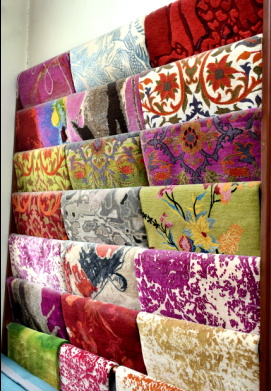 In the middle of the factory of Reliance Carpets in Boudha, I stood awestruck. It was an atmosphere I had never experienced before; the room was lively with music, laughter, and murmurs, while the thumps of the comb continued intermittently. The weavers were glowing under the fluorescent lights. Ms. Lobsangwas right; when one works in the carpet industry, they get to work with family.
In the middle of the factory of Reliance Carpets in Boudha, I stood awestruck. It was an atmosphere I had never experienced before; the room was lively with music, laughter, and murmurs, while the thumps of the comb continued intermittently. The weavers were glowing under the fluorescent lights. Ms. Lobsangwas right; when one works in the carpet industry, they get to work with family.
The soft-spoken and passionate Lobsang Dolama is the owner of Reliance Carpets, a company that is renowned for its high quality carpets. She has been keeping the company stable since 1988, when her parents asked her to look after it. She has used the carpet industry not just as a way to preserve and promote art, but also as a way to do community service. As I observed her interactions with the weavers, it was clear to me that she was quite close to them. It also came as no surprise when I learned that Reliance Carpets is affiliated with an organization like STEP.
STEP is an association of carpet importers and retailers founded in 1995 in Switzerland that works for the welfare of the weavers and the sustainability of the carpet industry. They ensure that the weavers have living and working environments of good quality, that the production is eco-friendly, and that the companies do not employ children. There are thirteen companies in Nepal that have their fair trade label.
As Ms. Lobsang gave us a tour around, she informed that Reliance Carpets provides benefits to their weavers like living quarters and health care, as well as their children’s school fees. I wanted to learn more about what it was like working here. That is how I got to talk to Sita Tamang. We were seated in a dimly lit room. I was watching a weaver wind a ball of yarn with fascination when Sitaarrived. A shy woman with a kind and radiant smile, sheis just thirty-two years old. It has been a decade since she started working in this industry. She has four children, aged thirteen, eleven, nine, and six. All are getting educated through the company. She told me that what motivates her to continue working in this industry is that she can work even though she has kids. She was beaming when she said that she is content with her working life.
Back in the warm and colorful room behind Ms. Lobsang's home, she said that over the course of her career, she has noticed some changes. She reminisced about the days when they would get the orders for an entire year at the start of the year itself. They would then plan accordingly. However, now that is not the case. They survive on the buyer's interests; encouragement from their customers and satisfaction from their workers keep them going. She says that the value is increasing, but the workers are decreasing. They have about fifty permanent employees, and the rest is temporary, around a hundred to two hundred.
She noted that Nepali people don't understand that carpet weaving is an art, and that the weavers are artists, as they have a lot of knowledge. Instead of going to the Gulf countries to do labor, people can work in the carpet industry; it is a well-respected profession. After my conversation with her, I realized that the tale of the carpet industry in Nepal is an unfortunate one. There is high potential, economically as well as culturally, but there is not much of an audience here.
The industry’s narrative began with Tibetan refugees looking for a way to resettle, a story that started with positivity, but slowly fizzled out. It was in the 60’s when the Swiss showed interest in the carpets, seeing a future in the industry. The art was exported to many European nations. There was great demand and the profits were soaring, until their decline due to competition with other countries, issues of child labor, environmental concerns, lack of productive involvement from the government, inflation, and unrealistic demands from the labor unions.
The potential that the Swiss saw then, the carpet industry still has it, and knowing how satisfied Sitais with her work fills me with hope for this future of this industry. Hand-woven art is immortal, and an industry that is preserving something so important should be protected, too.









